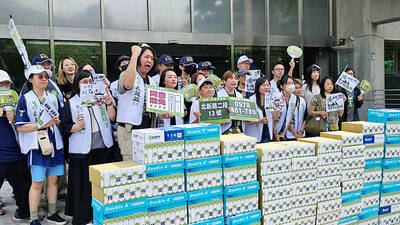In light of the threat posed to the Greater Taipei region by Chinese missiles, the military has said additional Patriot missile bases are needed in the region, on top of the three already in place, in order to ensure the protection of Taiwan’s political, military, and economic centers.
The China Military Power Report, released by the Ministry of Defense in September, said that the number of ballistic and cruise missiles which China’s Second Artillery Corps has aimed at Taiwan increased from 1,400 last year to more than 1,600 this year.
Currently, there are three Patriot missile bases in the Greater Taipei region — Wanli (萬里), Nangang (南港) and Sindian (新店) — which the military says serve to blunt any potential missile strikes against Taipei by Chinese forces.
The anti-ballistic capability of the Patriot missiles, as well as the long-range radar station located in the area which boasts a detection range deep into Chinese territory, would provide the Taipei region with an effective “umbrella” against missile attacks, the military said.
Pointing to the increased capability, accuracy and mobility of the People’s Liberation Army’s (PLA) Second Artillery Corp — as well as its increased deployment of Dong Feng-16 missiles [the newest mobile missile in the Chinese arsenal, capable of striking targets from a distance of 1,000km] — a Taiwanese general, who declined to be named, said the military had concluded that the anti-missile “umbrella” would need an additional surface-to-air anti-ballistic missile base.
Saying the location of the base was classified for reasons of national security, the military declined to comment on its planned whereabouts.
With the latest plan, the military is shifting its surface-to-air missile coverage ratio from that outlined by the administration of former president Chen Shui-bian (陳水扁) at 3:2:2 — in respect of missile bases located in the north, central and southern regions of Taiwan — to a new 4:2:1 ratio.
The previous administration had promised to set up missile bases in central and southern Taiwan to offer better protection to the Greater Taichung and Kaohsiung regions, nominating six ideal locations for the establishment of the missile bases, the general said.
After President Ma Ying-jeou (馬英九) came to power in 2008, economic woes took priority, forcing the ministry to aim for a first-phase establishment of four new missile bases — one in the north, two in the Greater Taichung area, and one in the Kaohsiung-Pingtung area, the general said.
The Chen administration had been focused on a balanced distribution of missile bases — a focus slightly more political than strategic — the general said, adding that the military’s current focus was based on the “level of threat” faced by various regions.
That focus helped to determine the priority of the establishment of new missile bases and is a decision based on overall strategic thinking.
“It is not placing the north over the south, nor is it favoring the pan-blue over the pan-green region,” the general said.
Political demographics in Taiwan traditionally demarcate northern Taiwan as more supportive of the pan-blue camp and southern Taiwan as more sympathetic to the pan-green camp, which is why the general sought clarify the matter.
Reached for comment, Ministry of National Defense spokesman Major General David Lo (羅紹和) said it was standard ministry practice not to comment on military deployments and declined further comment.

The Ministry of Education (MOE) is to launch a new program to encourage international students to stay in Taiwan and explore job opportunities here after graduation, Deputy Minister of Education Yeh Ping-cheng (葉丙成) said on Friday. The government would provide full scholarships for international students to further their studies for two years in Taiwan, so those who want to pursue a master’s degree can consider applying for the program, he said. The fields included are science, technology, engineering, mathematics, semiconductors and finance, Yeh added. The program, called “Intense 2+2,” would also assist international students who completed the two years of further studies in

Former president Tsai Ing-wen (蔡英文) departed for Europe on Friday night, with planned stops in Lithuania and Denmark. Tsai arrived at Taiwan Taoyuan International Airport on Friday night, but did not speak to reporters before departing. Tsai wrote on social media later that the purpose of the trip was to reaffirm the commitment of Taiwanese to working with democratic allies to promote regional security and stability, upholding freedom and democracy, and defending their homeland. She also expressed hope that through joint efforts, Taiwan and Europe would continue to be partners building up economic resilience on the global stage. The former president was to first

Taiwan will now have four additional national holidays after the Legislative Yuan passed an amendment today, which also made Labor Day a national holiday for all sectors. The Chinese Nationalist Party (KMT) and Taiwan People’s Party (TPP) used their majority in the Legislative Yuan to pass the amendment to the Act on Implementing Memorial Days and State Holidays (紀念日及節日實施辦法), which the parties jointly proposed, in its third and final reading today. The legislature passed the bill to amend the act, which is currently enforced administratively, raising it to the legal level. The new legislation recognizes Confucius’ birthday on Sept. 28, the

MORE NEEDED: Recall drives against legislators in Miaoli’s two districts and Hsinchu’s second district were still a few thousand signatures short of the second-stage threshold Campaigners aiming to recall Chinese Nationalist Party (KMT) legislators yesterday said they expect success in 30 out of 35 districts where drives have passed the second-stage threshold, which would mark a record number of recall votes held at once. Hsinchu County recall campaigners yesterday announced that they reached the second-stage threshold in the recall effort against Legislator Lin Szu-ming (林思銘). A total of 26,414 signatures have been gathered over the past two months, surpassing the 10 percent threshold of 23,287 in Hsinchu County’s second electoral district, chief campaigner Hsieh Ting-ting (謝婷婷) said. “Our target is to gather an additional 1,500 signatures to reach